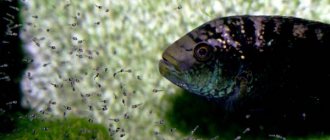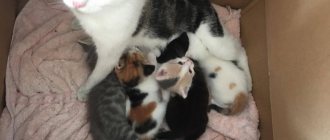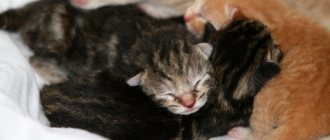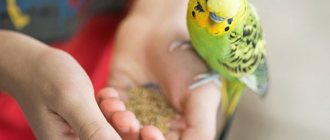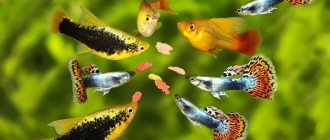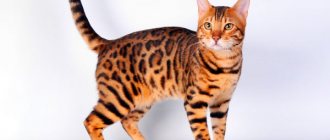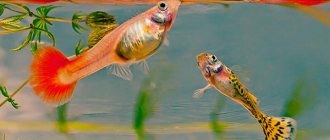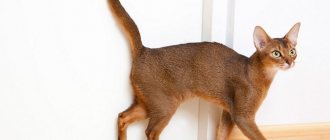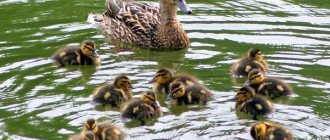Nutrition of adult finches
The basis of the diet of an adult is grain mixtures. Most breeders use ready-made food, but you can prepare the mixture yourself.
The base is formed from red millet, to which is added:
- canary seed;
- oatmeal;
- flax-seed;
- rape;
- salad;
- mogaru;
- hemp and meadow grass seeds.
The homemade mixture must contain at least 6 components.
The second important component for feeding finches is soft food rich in protein. To prepare it, mix:
- fresh carrots;
- grated boiled egg yolk;
- meadow grass seeds;
- crushed egg shells.
20-30 minutes after serving, the mixture is removed, otherwise the food will sour and cause indigestion.
The third important component when forming a diet is live food. Birds can be fed mealworms, bloodworms, fly larvae, mosquitoes and caterpillars. Live food is useful during the period of reproduction, active growth and recovery.
Sometimes birds can be treated to treats: fresh grass, salad, fruits and berries.
Amadins like it:
- dandelion grass;
- fresh cucumbers;
- pieces of zucchini and pumpkin;
- slices of apples and pears.
Zebra finches love fresh corn, peas, cabbage and spinach, and rice finches love hulled grains of rice or oats.
In addition to food, the cage should have 2 drinking bowls:
- with water - to quench thirst;
- with a mixture of river sand, shells and mashed eggshells - to improve digestion.
Grain mixtures
Grain mixtures are the basis of a bird’s diet, because they can be purchased in a ready-made form at a pet store. Feeding itself does not cause any difficulties - just pour the grain into the feeder and forget about feeding until the next day. But there are many more nuances here that beginners are not even aware of.
- Firstly, when purchasing a grain mixture, you need to consider the composition - the product should consist of 60% millet. Millet is a mixture of yellow, grey, white and red grains. Owners of finches make the mistake of purchasing a universal mixture - only the composition for exotic birds is suitable for these birds. It is better if the grain mixture is intended specifically for finches.
- Secondly, you should make sure that the mixture does not include millet, since its long-term storage leads to spoilage of the product, and this causes intestinal disorders in pets. If you have millet in the house, you can cook hard-boiled porridge from it - finches like this crumbly dish.
- Third, the content of millet in the grain mixture should vary depending on the period of the birds. During the rest period, the millet content can be increased to 65%, but when raising chicks it is reduced to 55%.
Owners of finches often start feeding in the evenings, which is wrong. It is recommended to feed these exotic birds in the morning. Place 1-1.5 teaspoons of mixture into the feeder for one bird. In the future, the rate per day is increased or decreased depending on the individual characteristics of the pets. The presented grain rate is calculated taking into account the additional nutrition that birds should receive daily.
Amadins are allowed to give unpeeled sunflower seeds, as well as weed seeds, of which there are many in the summer cottage in the autumn.
Nutrition during the hatching period
- Preparing birds for laying - increase the portions of greens and grass in the diet.
- Hatching eggs - birds should eat greens with the addition of live food.
- A couple of days before the chicks appear, grain mixtures, soft food with a boiled egg are returned, and greens are reduced to 3 times a week.
- Feeding - finches need grain mixtures, eggs and porridge cooked in water.
Sprouted grain
Sprouted grain contains vitamins and microelements that have a positive effect on the health of pets. Therefore, the remaining grain mixture in the feeder can be sprouted and given back to the birds in separate containers no more than 2 times a week. You can choose to use another feeding option - feed the finches with sprouted grain for two weeks, and then take a break for a whole month.
Before feeding, it is important to monitor the condition of the sprouted grain - it should not turn sour. To prevent this from happening, the grains are washed with water in advance during the sprouting process.
Often a container with soil is used for germination. It can be placed directly in the finches’ cage so that the birds themselves “track” the sprouted shoots. If this is used, you should use only real garden soil without additional impurities. You cannot use purchased soil, since they always contain additional minerals. Birds, along with sprouts, can also consume soil, which will cause digestive problems.
Feeding mode of finches
- grain feed – 1-1.5 tablespoons daily;
- mineral feeding in the form of a mixture of sand, shells and chalk - constantly in the cage;
- protein feeding in the form of soft food - once a week, at the rate of 1 tsp. per individual;
- protein feeding in the form of live food - no more than once a week, 5-10 worms per bird;
- plant components (herbs, cucumbers, vegetables, peppers) – in small pieces at least 3 times a week;
- berries and dried fruits – no more than once a week.
Authorized Products
- Grain mixtures;
- Soft food - grated carrots mixed with a boiled chicken egg, meadow grass seeds, cottage cheese or steamed bread;
- Plant food - dandelion, nettle, chamomile, green pepper, lettuce, clover, sedge, alfalfa;
- Sprouted cereals – buckwheat, wheat, barley, oats;
- Vegetables and fruits - pumpkin, cucumber, cabbage, apples, pears, bananas, peas, corn;
- Live food – mealworms, bloodworms, shell rock.
What to feed finches?
The Japanese finch is often found in the collections of bird lovers and is (along with the zebra finch and rice finch) one of the most popular species of these cute birds. It is quite simple to maintain; the owner of Japanese finches should only follow simple rules for caring for these birds so that they can delight him with their grace and gentle chirping for a long time. First, you should find out what to feed finches in captivity.
What food is needed for Japanese finches
In order for these birds to always feel excellent and reproduce well, their food must be varied. When planning to buy Japanese finches, you will need to acquire the following food and supplements:
- high-quality and always fresh grain mixture;
- green food and vegetables;
- nutritional mixture containing eggs;
- sprouted grains;
- mineral fertilizer.
All feed must be given in accordance with the norm calculated for one bird per day.
The basis of the grain mixture for Japanese finches is millet; it should also include canary seed, rapeseed, and flaxseed. Before purchasing a grain mixture, be sure to pay attention to its composition, because very often unscrupulous manufacturers add ingredients to the mixture that are completely unnecessary for finches to make it heavier. If you wish, you can purchase all the components separately and make the grain mixture yourself.
Greens contain many vitamins that birds need. Birds readily eat plantain, lettuce, and dandelion leaves as greens. Greens collected on the street must be thoroughly washed under running water, after which they must be thoroughly dried in order to prevent digestive upset in finches. Among vegetables, grated carrots are very useful for birds.
Sprouted grain is very nutritious and contains a lot of essential substances, so it must be included in food for finches, especially during the breeding season. To germinate grain at home, you can get special containers. They are the easiest way to maintain the temperature and humidity necessary for seed germination. During germination, care should be taken to ensure that the grain does not become moldy. Food showing signs of mold should be thrown away immediately and should not be fed to birds under any circumstances.
A nutritional mixture consisting of finely chopped boiled eggs, grated carrots and crumbled white crackers is an important addition to the diet of Japanese finches during breeding. It ensures that the bird’s body receives the required amount of proteins, fats and carbohydrates, especially needed by finches during such a crucial period of their life. As for mineral supplements, be sure to buy sepia for your birds.
What should you not feed to finches?
If you already know what finches eat, then you should definitely know those foods that these birds should absolutely not be given. Foods prohibited for finches include some fruits (papaya, mango, avocado), millet, and bread. Do not give finches stale greens or moldy grain mixtures.
Preparing a couple for reproduction
2 weeks before the finches mate at home, the male is forced to move a lot. He is released from the cage into the room for a long time and allowed to fly to his heart's content. He will sit on the eggs together with the female. During this period, a mineral supplement is also needed in his diet.
In the female finch, preparation for reproduction lasts longer - 3 weeks. In the first week, she cleanses her body with sulfur-containing supplements. Next week, complex vitamin supplements will be included in her diet. In the third week, increase calcium intake. Calcium gluconate is added to the drink, and crushed eggshells are added to the food.
The preparatory process and laying of eggs should occur after molting or long before it begins. During this period, birds experience great stress on their immune system. Nesting that coincides with the molt will take away their last strength. Sulfur-containing additives for molting birds are given little by little during the mating season.
It’s good when birds nest in the warm season, then there will be no problems with lighting and heating. In winter, birds are stimulated to reproduce by increasing daylight hours. To do this, install lamps and turn them on in the evenings. The total duration of the photoperiod should be 14 hours per day. For this, fluorescent lamps are used.
What to feed finches?
07.20.2016 , Posted in Amadin Comments One comment
Feeding pet parrots is an important stage for the quality life of little birds. Every owner should have a sound understanding of what food can be offered to their feathered pets, and what is better not to offer at all. A balanced diet will allow the finch to be a cheerful and active creature. Life expectancy also depends on the quality of food; for example, finches in nature live from 3 to 5 years, but in captivity they can live about 10 years.
Fruits, vegetables and vitamins
Green food should also be present in the diet of finches. Although these birds do not like to feast on fruit as much as macaws. At first, the parrots will refuse such a delicacy, but over time they will get used to it and will look forward to the garland and vegetables or fruits or vitamin gruel.
What fruits and vegetables can be given to a finch parrot? Every person who decided to have these mischievous birds should know this. Amadina can be given: cucumbers, sweet bell peppers, cabbage, pumpkin, clover, carrots, pears, apples, peach and banana. The following plant foods are prohibited: avocado, onion, papaya, parsley, mango, celery, persimmon and dill. If you do not overuse fruits and vegetables, and do not give prohibited foods, you can provide your parrot with a healthy, nutritious diet.
Finches also love to feast on insects. In pet stores you can find special “live” additives, which are presented in the form of moths, maggots or mealworms. Such food should be periodically present in your feathered pet’s feeder. Parrots that are in the process of breeding especially need insects.
Care of offspring
After the chicks appear, the owner must carefully monitor their condition and the behavior of their parents. Finches usually take good care of their offspring, but in some cases, the intervention of a poultry farmer may be required to maintain the health of the young.
READ Australian Terrier: photo of the dog, description of the breed, price
At first, after the chicks hatch, only the female feeds them, and after 10-15 days the male joins her. When young finches begin to leave the nest, the female stops feeding them; the male continues to do this until the young animals switch completely to independent feeding.
Parents feed the chicks by regurgitating semi-digested food masses from the crop into their beaks. During the period of feeding the offspring, the amadine's diet should include an increased amount of soft food rich in protein: boiled eggs, low-fat cottage cheese, insects. When young birds begin to fledge, seeds of weeds and meadow grasses, spikelets of milky-wax ripeness and vitamin and mineral supplements should be included in the parents' diet.
If finches refuse to hatch chicks, the owner will have to feed them himself. Young finches are ready to feed within a few hours after birth. You should not feed the chicks until the first feces have passed - this can lead to their death.
To artificially feed finches, they use baby food that does not contain milk, or formulas specially designed for feeding chicks, sold in pet stores. They are diluted with warm water to a temperature of 39°C and injected into the beak using a disposable syringe without a needle or with special nozzles.
A syringe with special attachments for feeding chicks.
Amadine chicks need to be fed frequently. During the first 3 days after hatching, the procedure is carried out every half hour to an hour during the day and every 2 hours at night. From the 4th to the 7th day of life, finches are fed every hour and a half during the day and every 3 hours at night. At the age of 8-15 days, young animals are transferred to feeding every 1.5-2 hours during the day, and at night they take a break from 0:00 to 6:00 hours. At the age of 16-30 days, daytime breaks are increased to 2-4 hours, and night breaks are left the same.
READ Otocinclus: Types, maintenance, care, reproduction, breeding, compatibility, feeding
As the birds grow older, they are offered an increasingly thick mixture, and after they reach 30 days of age, they begin to be taught to feed themselves. For the first feeding, liquid porridge made from crushed millet, boiled in sweetened water, is well suited. A week later, mash is introduced into the diet, and after another week - seeds and grains, including sprouted ones.
The chicks are placed in a box or box lined with soft cloth. The top of the nest is covered with a cloth and placed near a heating source. You can create the required temperature using a heating pad, thermal cord, thermal mat or incandescent lamp. The temperature inside the nest should be maintained at 36-38°C for the first 7 days, 30-35°C for the next week, and then reduced to 22-25°C. Air humidity is maintained at 60-70% by placing a container of water near the nest.
Possible problems
If there is a lack of B vitamins in the diet, chicks may experience deformation of their claws and beaks. In this case, you should increase the supply of boiled eggs and raw sunflower seeds to the finches. It is recommended to include small amounts of nuts, brewer's yeast, buckwheat or rice porridge into the diet.
After leaving the nest, parents may begin to drive the chicks away and pluck their feathers. This is due to preparation for the next laying. If signs of aggression appear in adult finches, the young should be placed in a separate cage.

